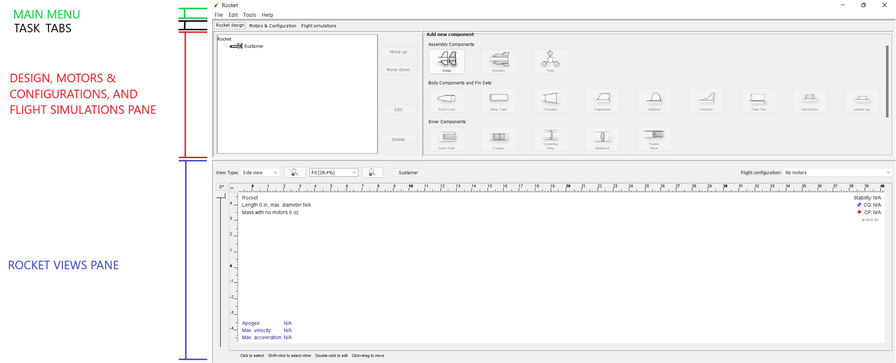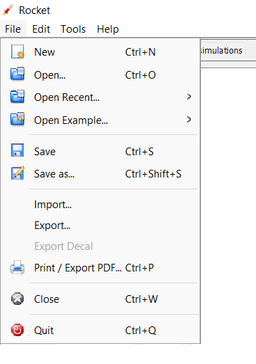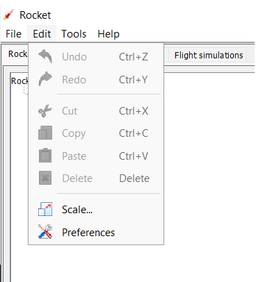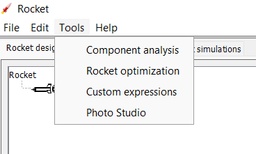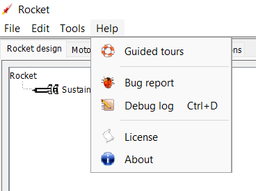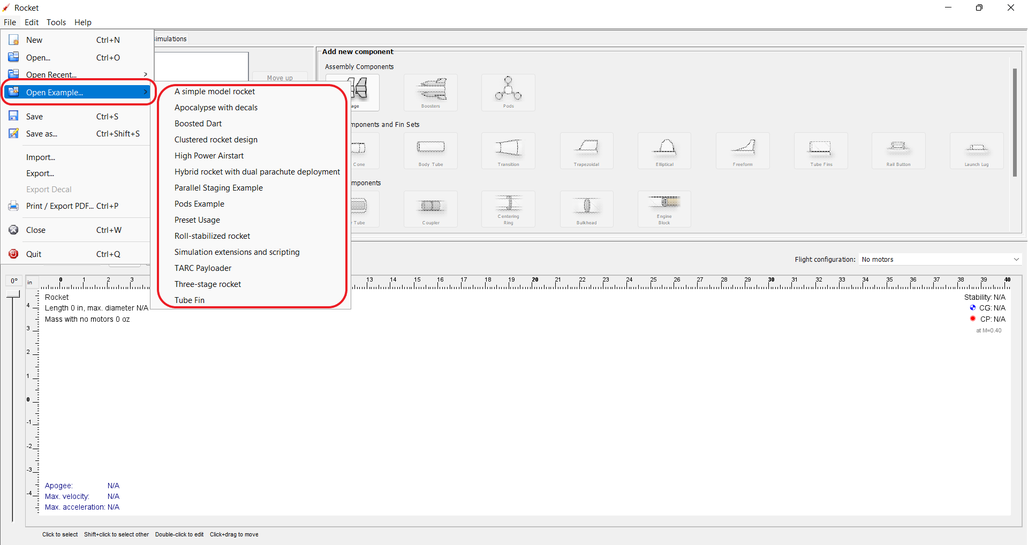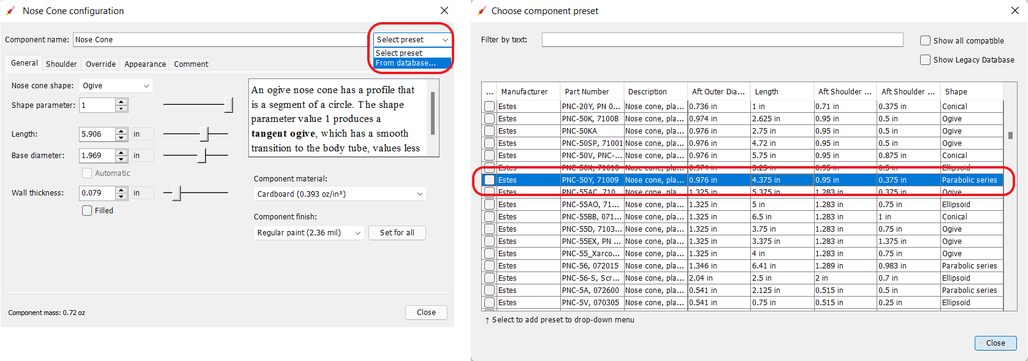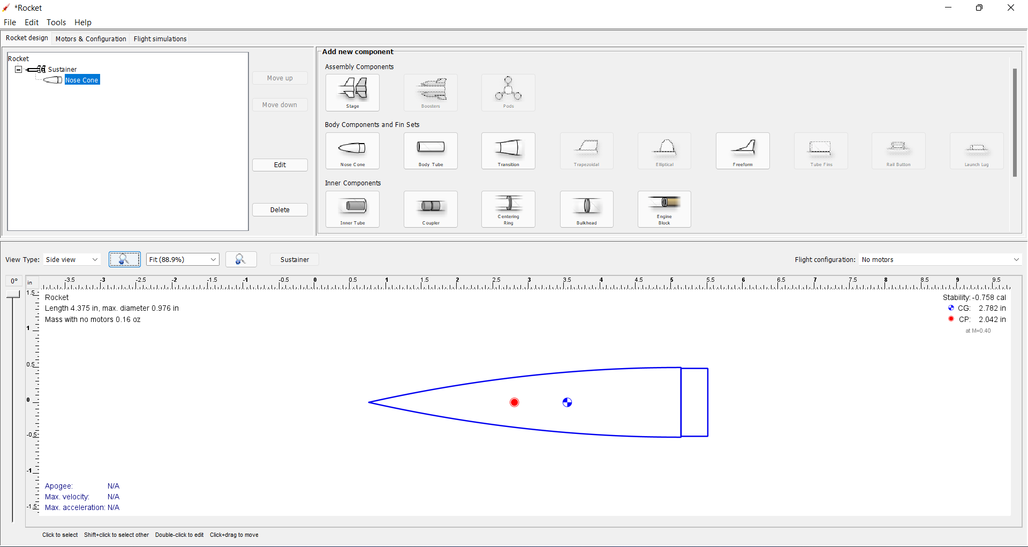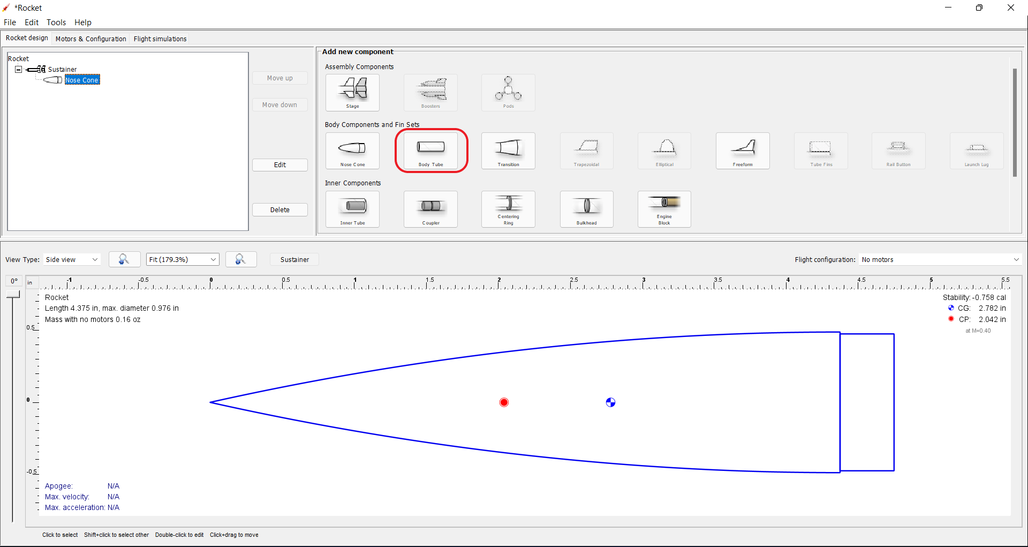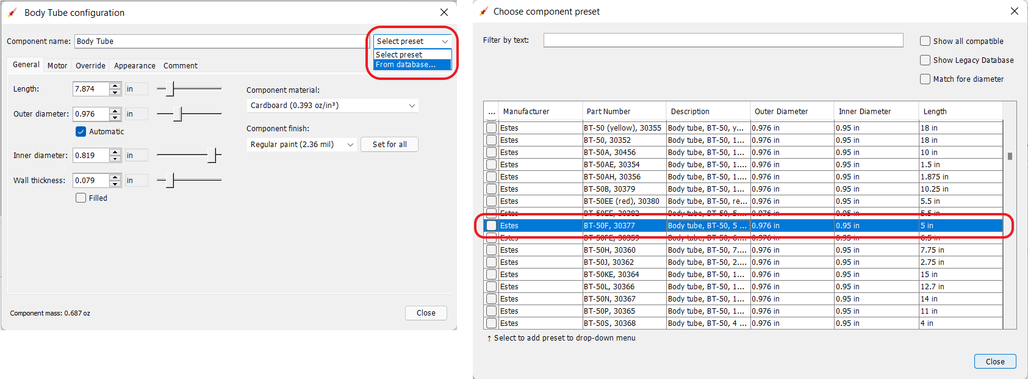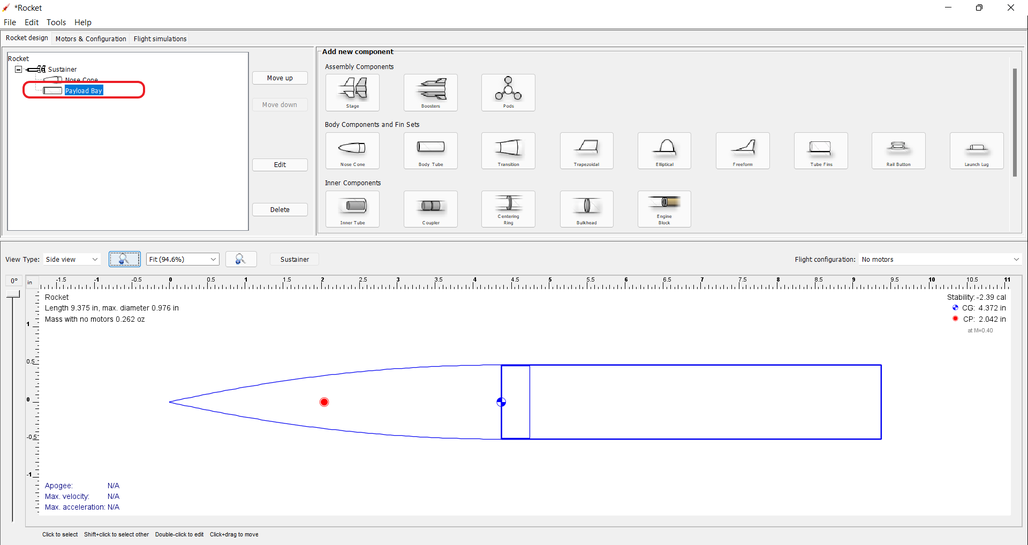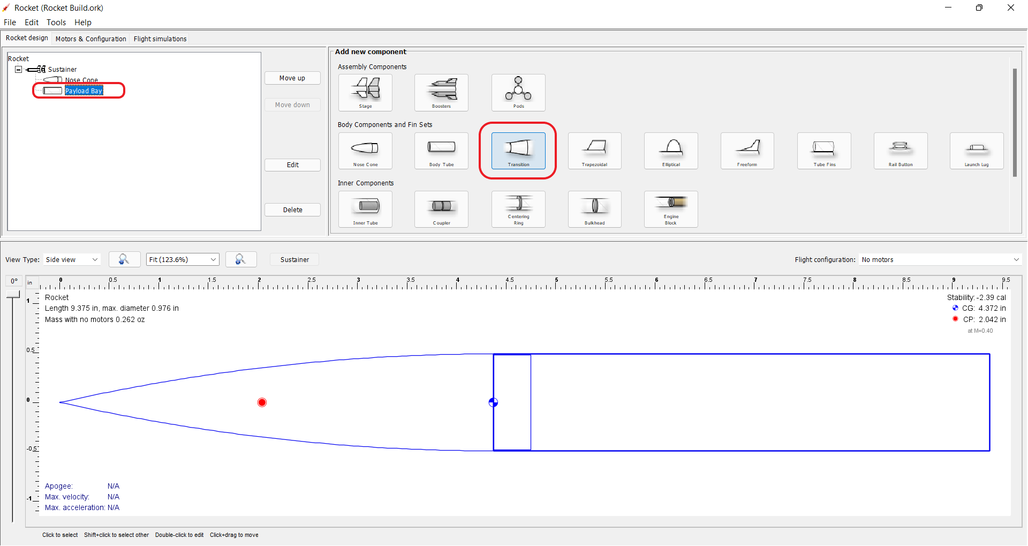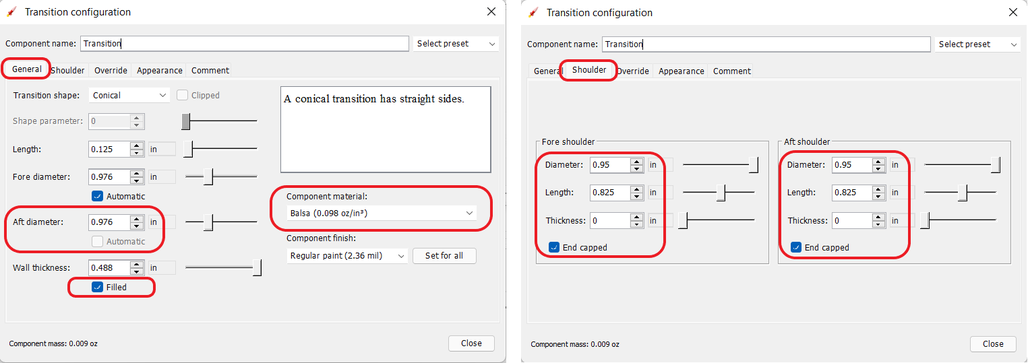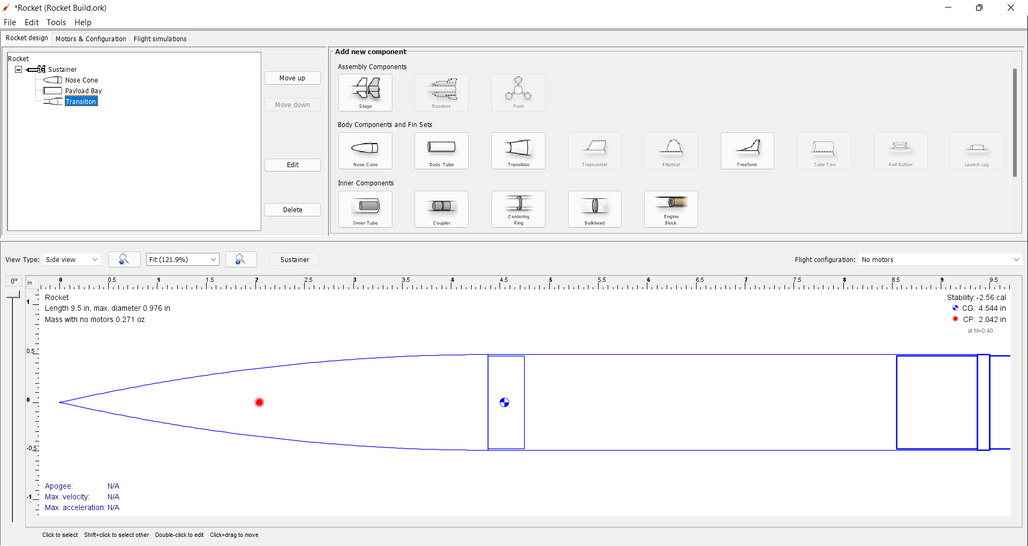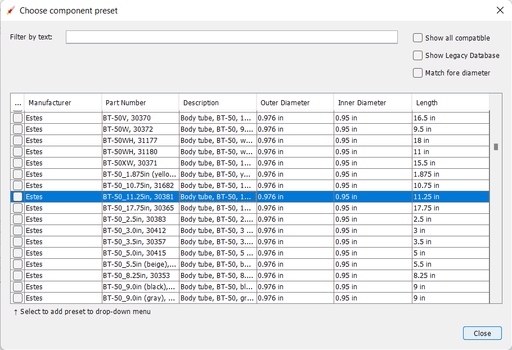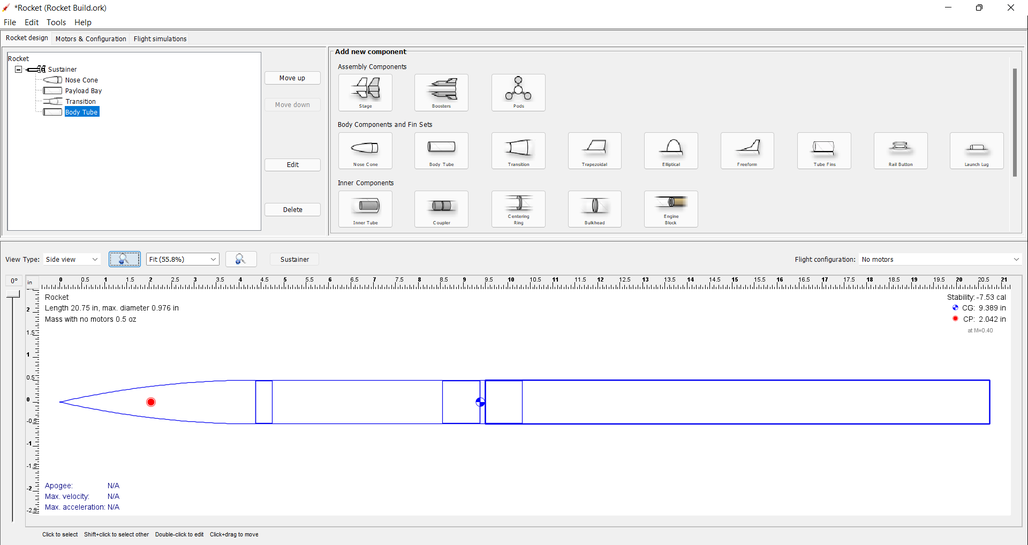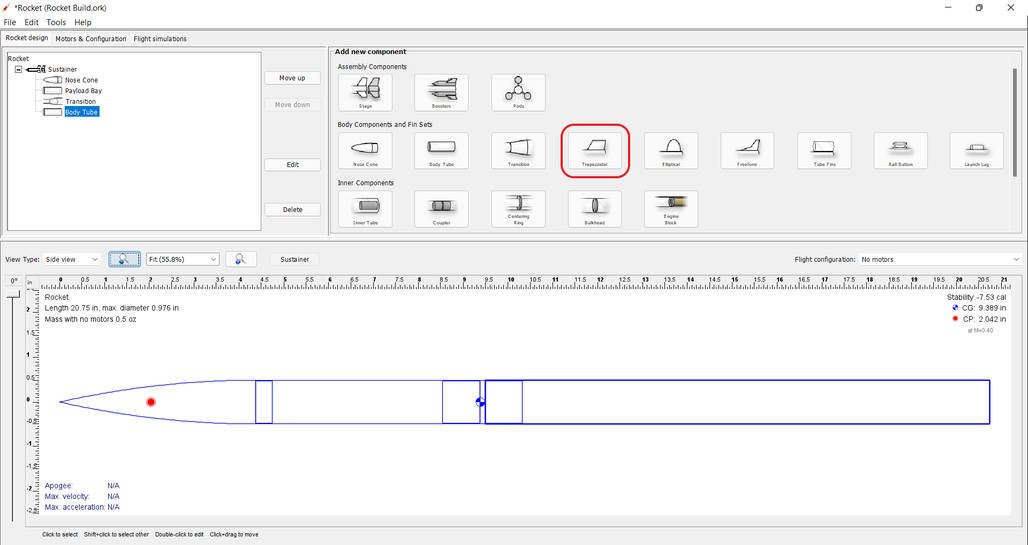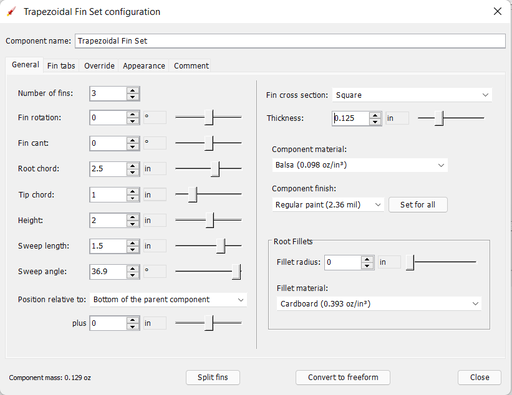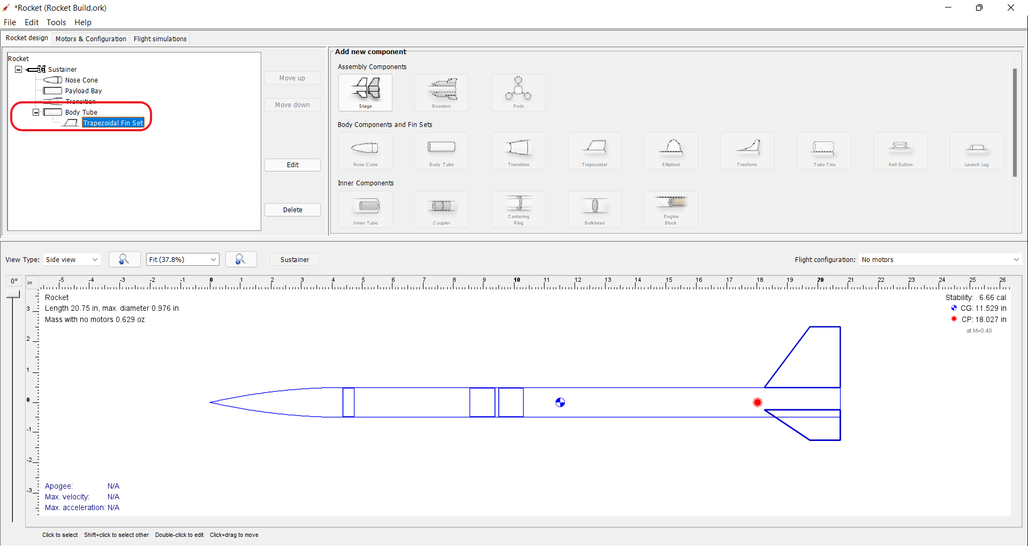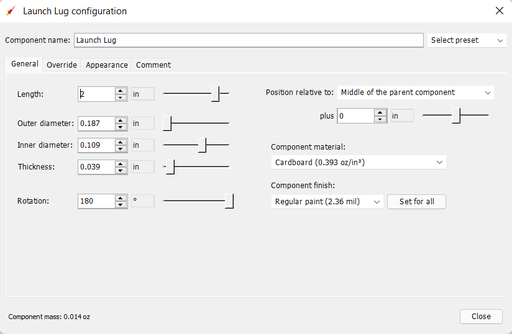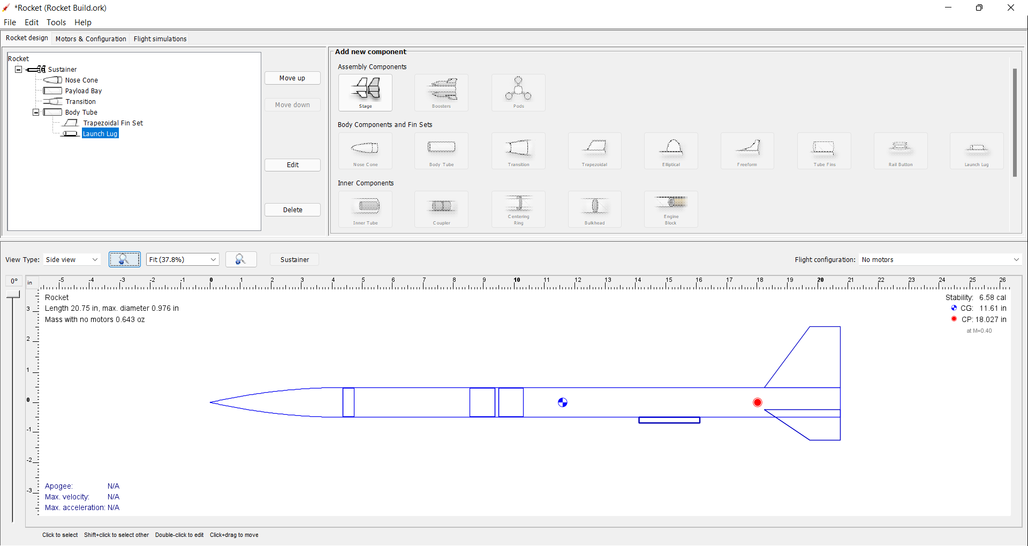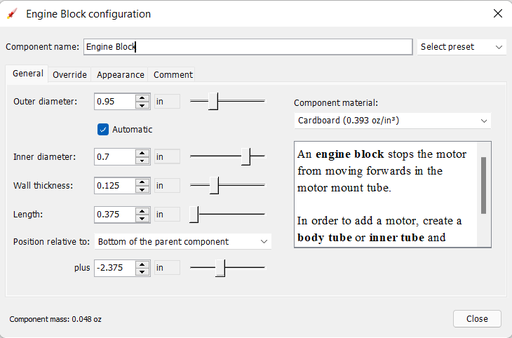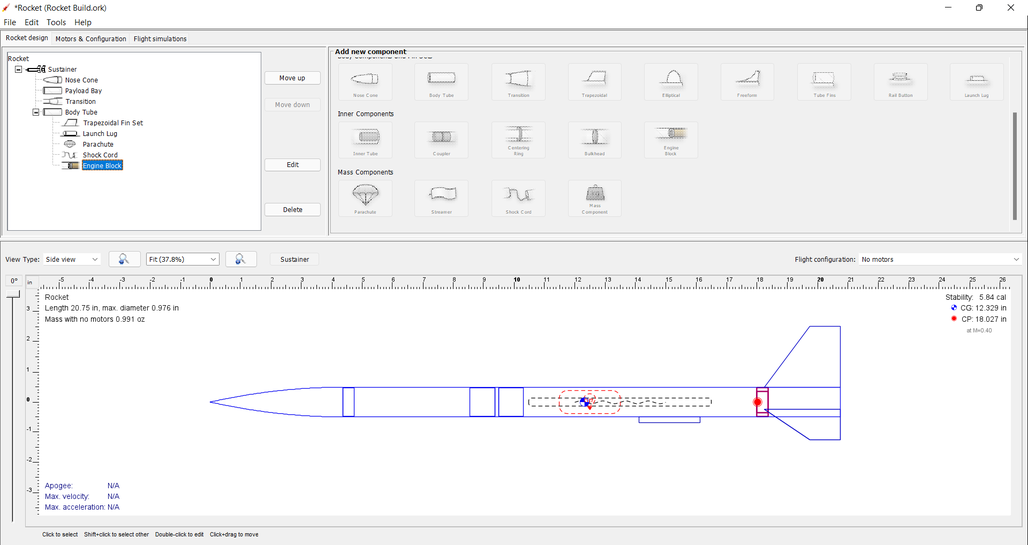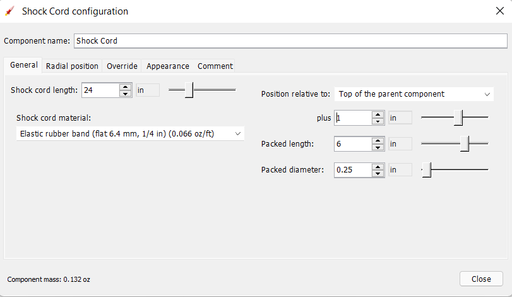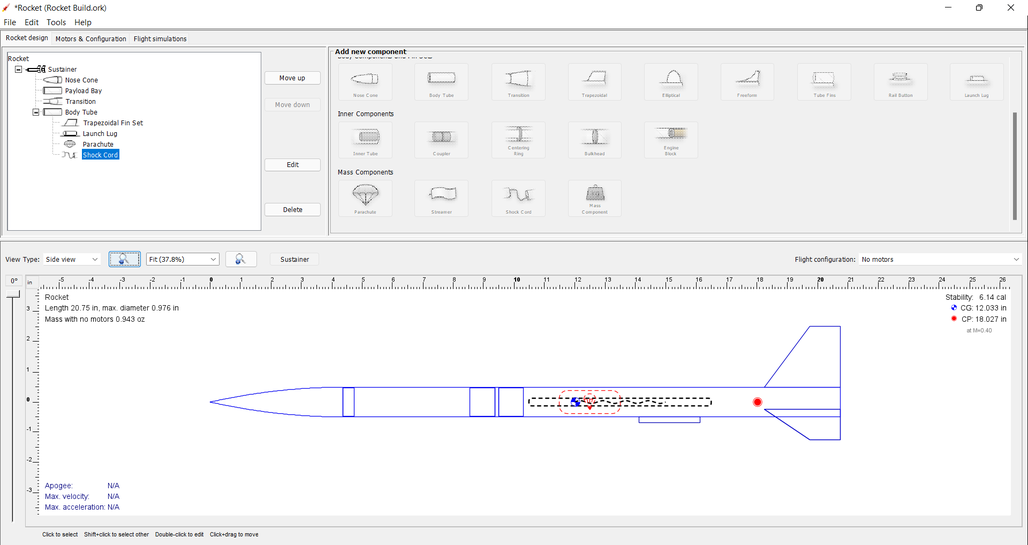|
|
| Line 415: |
Line 415: |
| | | | |
| | We now analyze the four <em>main window</em>'s menus, briefly explaining the function of each of the menus' options. | | We now analyze the four <em>main window</em>'s menus, briefly explaining the function of each of the menus' options. |
| − |
| |
| − |
| |
| − | == The <em>File</em> menu ==
| |
| − |
| |
| − | The image below shows the options offered by the <strong><em>File</em></strong> menu, located in the top left-hand corner of OpenRocket's <em>main window</em>.
| |
| − |
| |
| − |
| |
| − | [[File:File.png|thumb|219 px|center|The <em>File</em> menu.]]
| |
| − |
| |
| − |
| |
| − | The function of each option in the <em>File</em> menu is pretty straightforward to understand: <br />
| |
| − | - <strong><em>New</em></strong> allows you to start a new project, without closing the project that is currently open. <br />
| |
| − | - <strong><em>Open...</em></strong> allows you to open a <em>*.ork</em> file that you have saved on your computer. <br />
| |
| − | - <strong><em>Open example...</em></strong> allows you to open one of the example projects (more on these later). <br />
| |
| − | - <strong><em>Save</em></strong> saves the changes you have made to a previously-saved project. <br />
| |
| − | - <strong><em>Save as...</em></strong> allows you to save the project you are working on to a new <em>*.ork</em> file. <br />
| |
| − | - <strong><em>Print/Export PDF</em></strong> opens a window like the one shown below (if you have already completed your rocket's design). From here you can select what to include in your print/PDF file; such as technical details of your rocket's components, templates of your rocket's fin sets, or even the design of your rocket. We suggest you try this option with one of the example projects to understand how each of these is represented when printing/exporting to PDF. More on printing and exporting to PDF in [[Rocket Analysis]].
| |
| − | <br />
| |
| − | - <strong><em>Close</em></strong> closes the current project (after asking for confirmation if there are unsaved changes). This will also exit the application if there was only one project open. <br />
| |
| − | - <strong><em>Quit</em></strong> exits the application, checking that you have saved all open projects.
| |
| − |
| |
| − |
| |
| − | [[File:PDF.png|thumb|431 px|center|The window that opens when <em>Print/Export PDF</em> is selected.]]
| |
| − |
| |
| − |
| |
| − | == The <em>Edit</em> menu ==
| |
| − |
| |
| − | The image below shows the options offered by the <strong><em>Edit</em></strong> menu.
| |
| − |
| |
| − |
| |
| − | [[File:Edit.png|thumb|154 px|center|The <em>Edit</em> menu.]]
| |
| − |
| |
| − |
| |
| − | These options are mostly the classic editing options: undo/redo some action (<strong><em>Undo</em></strong>/<strong><em>Redo</em></strong>) and cut/copy/paste/delete some element (<strong><em>Cut</em></strong>/<strong><em>Copy</em></strong>/<strong><em>Paste</em></strong>/<strong><em>Delete</em></strong>). We also have the following options: <br />
| |
| − | - <strong><em>Scale...</em></strong> opens the window shown below. Here you can choose to scale your rocket's size by some percentage (you can select from a range of 25% to 400%), starting from a specified dimension that can either be the one the rocket currently has or one you specify. By checking or unchecking the <em>Update explicit mass values</em> box, you can also decide whether or not the rocket's mass should be updated when scaling its volume.
| |
| − |
| |
| − |
| |
| − | [[File:Scale.png|thumb|350 px|center|The <em>Scale</em> window.]]
| |
| − |
| |
| − |
| |
| − | - <strong><em>Preferences</em></strong> opens the <em>Preferences</em> window, as shown below. At the top of this window there are seven tabs which allow you to switch between various preference panes.
| |
| − |
| |
| − | From the <em>General</em> pane, you can change the <strong>Interface Language</strong> to one of 13 translations. You'll need to restart OpenRocket to make the change take effect.
| |
| − |
| |
| − | You can also load <strong>User-defined thrust curves</strong>, for motors not yet represented in OpenRocket's library.
| |
| − |
| |
| − | From this pane, you can also check for an <strong>Update</strong>, or set your preferences for <strong>Update checking</strong>.
| |
| − |
| |
| − |
| |
| − | <div style="background-color:#FFFF00;border:1px solid black;margin:5px;padding:5px;"><strong>At this writing (December 2020), OpenRocket 15.03 tries to contact an out-of-date update source, and will not find future updates</strong>.
| |
| − | <br/>You should <em>un-check</em> this box, and periodically check [http://openrocket.info/ OpenRocket.info] for information on the latest version.</div>
| |
| − |
| |
| − |
| |
| − | [[File:Prefs-General.png|thumb|1000 px|center|The <em>General</em> pane of the <em>Preferences</em> window.]]
| |
| − |
| |
| − |
| |
| − | The <strong>Design</strong> tab brings up a preference pane where you can tell OpenRocket where to <strong>Position new body components</strong>, the default <strong>Size of text</strong>, the <strong>Default Mach number</strong> for Center of Pressure estimation, and OpenRocket's behavior in the <em>Design</em> window.
| |
| − |
| |
| − |
| |
| − | [[File:Prefs-Design.png|thumb|1000 px|center|The <em>Design</em> pane of the <em>Preferences</em> window.]]
| |
| − |
| |
| − |
| |
| − | The <strong>Simulation</strong> tab brings up a preference pane where you can control OpenRocket's behavior when working with simulations, and the options it uses for calculation in the <em>Flight simulations</em> window.
| |
| − |
| |
| − |
| |
| − | [[File:Prefs-Simulation.png|thumb|1000 px|center|The <em>Simulation</em> pane of the <em>Preferences</em> window.]]
| |
| − |
| |
| − |
| |
| − | The <strong>Launch</strong> tab brings up a preference pane where you can fix OpenRocket's default <strong>Wind</strong>,<strong>Atmospheric conditions</strong>, <strong>Launch site</strong>, and <strong>Launch rod</strong>, as used in the <em>Flight simulations</em> window.
| |
| − |
| |
| − |
| |
| − | [[File:Prefs-Launch.png|thumb|1000 px|center|The <em>Launch</em> pane of the <em>Preferences</em> window.]]
| |
| − |
| |
| − |
| |
| − | The <strong>Units</strong> tab brings up a preference pane where you can set your <strong>preferred units</strong> for every parameter, and completely reset <strong>metric</strong> or <strong>imperial</strong> units as used in all <em>OpenRocket</em> inputs.
| |
| − |
| |
| − |
| |
| − | [[File:Prefs-Units.png|thumb|1000 px|center|The <em>Units</em> pane of the <em>Preferences</em> window.]]
| |
| − |
| |
| − |
| |
| − | The picture below shows the <em>Materials</em> pane of the <em>Preferences</em> window. Here you can manage all of the available materials for the rocket component, by either <strong>editing the characteristics</strong> of the materials (i.e., their name and density) through the <em>Edit</em> button, or you can <strong>delete</strong> a material through the <em>Delete</em> button. You can also <strong>add new materials</strong> if you wish, by clicking the <em>New</em> button and setting the material's name, type and density.
| |
| − |
| |
| − |
| |
| − | [[File:Materials.png|thumb|1000 px|center|The <em>Materials</em> pane of the <em>Preferences</em> window.]]
| |
| − |
| |
| − |
| |
| − | The <strong>Graphics</strong> tab brings up a preference pane where you can choose your preferred <strong>Graphics Editor</strong> (for example, Photoshop, MS-Paint, GIMP, Affinity Photo, etc.), and enable and set parameters for <strong>3D Graphics</strong> in the <em>Rocket design</em> window.
| |
| − |
| |
| − |
| |
| − | [[File:Prefs-Graphics.png|thumb|1000 px|center|The <em>Graphics</em> pane of the <em>Preferences</em> window.]]
| |
| − |
| |
| − | == The <em>Tools</em> menu ==
| |
| − |
| |
| − | The image below shows the options offered by the <strong><em>Tools</em></strong> menu.
| |
| − |
| |
| − |
| |
| − | [[File:ToolsMenu.png|thumb|173 px|center|The <em>Tools</em> menu.]]
| |
| − |
| |
| − |
| |
| − | - The <strong><em>Component analysis</em></strong> option opens a window like the one shown below. Here, technical information for the rocket's <strong>external components</strong> and fin sets is displayed. Using the scroll bars in the top half of the window you can also change some parameters, such as <strong>wind direction</strong>, <strong>angle of attachment</strong>, <strong>mach number</strong> and <strong>roll rate</strong>. More on the <em>component analysis</em> window in [[Rocket Analysis]].
| |
| − |
| |
| − |
| |
| − | [[File:Component analysis.png|thumb|812 px|center|The <em>Component analysis</em> window, opened from the <em>A simple model rocket</em> example design.]]
| |
| − |
| |
| − |
| |
| − | - The <strong><em>Rocket optimization</em></strong> option opens a window like the one shown below. From here you can optimize the performance of your rocket by selecting exactly which performance to optimize from the <strong><em>Optimized</em></strong> drop-down list. More on the <em>rocket optimization</em> window in [[Rocket Analysis]].
| |
| − |
| |
| − |
| |
| − | [[File:Optimization.png|thumb|992 px|center|The <em>Optimization</em> window, opened from the <em>A simple model rocket</em> example design.]]
| |
| − |
| |
| − |
| |
| − | - The <strong><em>Custom expressions</em></strong> option opens a window for adding and editing custom expressions, as shown below. In OpenRocket, you're not limited to using the built-in simulation variables in your plots and analysis. With the custom expression feature, you can write expressions to calculate other values of interest during the simulation. These can then be plotted or exported just like the built-in variables. More on the <em>Custom Expression</em> window in [[Custom Expressions]].
| |
| − |
| |
| − |
| |
| − | [[File:CustomExpressions.png|thumb|731 px|center|The <em>Custom Expressions</em> window.]]
| |
| − |
| |
| − |
| |
| − | - OpenRocket's <strong><em>Photo Studio</em></strong> (seen below) lets you visualize your rocket in flight, over a variety of backgrounds, in a variety of attitudes and lighting. Effects let you customize its engine exhaust and the way it's depicted. You can adjust parameters with the dialog panel, and adjust the view with the mouse. The best way to learn about the Photo Studio is to start playing with it - it's pretty fun, and if you've given your rocket color and assigned realistic materials, it can look very good!
| |
| − |
| |
| − |
| |
| − | [[File:PhotoStudio.png|thumb|1000 px|center|The <em>Photo Studio</em> window.]]
| |
| − |
| |
| − |
| |
| − | == The <em>Help</em> menu ==
| |
| − |
| |
| − | The image below shows the options offered by the <strong><em>Help</em></strong> menu.
| |
| − |
| |
| − |
| |
| − | [[File:Help.png|thumb|424 px|center|The <em>Help</em> menu.]]
| |
| − |
| |
| − |
| |
| − | The functions of the options in the <em>Help</em> menu are as follow: <br /><br />
| |
| − | - <strong><em>Guided tours</em></strong> opens a window containing guided tours of some of OpenRocket's functionality. These tours are works in progress, and not exhaustive. <br />
| |
| − |
| |
| − |
| |
| − | [[File:GuidedTours.png|thumb|738 px|center|The <em>Guided Tour</em> panel, with a tour open.]]
| |
| − |
| |
| − |
| |
| − |
| |
| − | - <strong><em>Bug report</em></strong> opens a bug report form that you can complete and email to the developers. <br />
| |
| − |
| |
| − |
| |
| − | <div style="background-color:#FFFF00;border:1px solid black;margin:5px;padding:5px;"><strong>At this writing (December 2020), OpenRocket 15.03 tries to contact an out-of-date bug-submission page, and will not submit the bug</strong>. You may see an error dialog with an email address. <strong>Do not</strong> submit to this email - it's not monitored.
| |
| − | <br/>Instead, fill out the report with steps to trigger, description, etc., then copy the text from this window and file your bug report as an issue at [https://github.com/openrocket/openrocket/issues OpenRocket's Issue List] on Github.</div>
| |
| − |
| |
| − |
| |
| − | [[File:BugReport.png|thumb|931 px|center|The <em>Bug Report</em> panel]]
| |
| − |
| |
| − |
| |
| − | - <strong><em>Debug log</em></strong> opens the OpenRocket debug log. The debug log is mostly of interest to developers. The log window lets you filter to see all kinds of information about what OpenRocket is doing.<br />
| |
| − |
| |
| − |
| |
| − | [[File:DebugLog.png|thumb|1408 px|center|The <em>Debug Log</em> panel.]]
| |
| − |
| |
| − |
| |
| − | - <strong><em>License</em></strong> opens a window containing OpenRocket's license. <br />
| |
| − | - <strong><em>About</em></strong> opens a window containing summary information about this project. <br /><br />
| |
|
The current User's Guide is very much a work in progress, any help would be greatly appreciated!
If you'd like to contribute something, just hit the 'Edit' tab at the top.
|
In this section we have a look at how OpenRocket is organized, by analyzing in detail the structure of the user interface. We will also briefly mention the Example projects that are accessible from the File menu. After reading this section you will have a thorough understanding of how OpenRocket is structured, and will be ready to start designing a rocket of your own. If you already know how this program is organized, feel free to jump to Basic Rocket Design, the next section.
The User interface
The OpenRocket user interface is divided horizontally into four sections, the Main Menu (green); the Task Tabs (black); the Rocket Design, Motors & Configuration, and Flight Simulation Pane (red), and the Rocket Views Pane (blue).
Main Menu
| Menu Item |
|
Description |
| File |
|
The File Menu is divided into five divisions by function, (1) file opening options; (2) file saving options; (3) import and export options; and (4) closing and (5) quiting options.
- - New allows you to start a new project, without closing the project that is currently open.
- - Open... allows you to open an *.ork file that you have previously saved on your computer.
- - Open Recent opens a pull-down menu of recently opened filed from which you may choose one to reopen.
- - Open Example allows you to select from and open an example project included with OpenRocket.
- - Save saves the changes you have made to a project that you have previously saved.
- - Save as... allows you to save the project you are working on to a new *.ork file.
- - Import allows you to import a previously saved Rocksim 10 *.rkt file.
- - Export allows you to export the project you are working on to a Rocksim 10 *.rkt file.
- - Export Decal allows you to export a decal *.jpg file (currently only the first decal).
- - Print/Export PDF allows you to select elements to print or export to a *.pdf" file from a drop-down menu; such as the technical details of your rocket's components, templates for your rocket's fin sets, or even the design of your rocket.
- - Close exits the current project (you will be asked whether to save unsaved changes); close also exits OpenRocket if there are no other open projects.
- - Quit exits OpenRocket, checking that you have saved all open projects.
|
|---|
| Edit |
|
The Edit Menu is divided into three types of operations, (1) undoing and redoing an action; (2) cutting, copying, pasting, and deleting components and text; and scaling the rocket and system preference. |
| Tools |
|
The Tools Menu provides design tools which allow the user to analyze the effect of specific components, optimize particular rocket characteristics, create custom expressions for specialized to analysis, and a photo studio which displays the rocket in 3D with a variety of backgrounds and effects. |
| Help |
|
The Help Menu is divided into three sections, (1) guided tours demonstrating the use of OpenRocket; (2) bug reporting and debugging tools to assist users provide feedback to the developers; and (3) licensing and version and other general information about OpenRocket. |
|---|
← Go to The User interface
Task Tabs
The windows shown below utilize the A simple model rocket example included with OpenRocket.
| Rocket Design |
|
|
The Rocket Design tab is divided into three sections, the component tree, component arrangement buttons, and component selection buttons. The components available in OpenRocket are divided into four classes based upon component function. These classes are assembly components, body components and fin sets (external components), internal components, and mass components (which include electronics and recovery components). Components are greyed out until it would be appropriate to add that component type. As components are added, you will see the component tree (on the left side of the window, grow with each component added. For a detailed description of each component, see Component Details.
|
| Motors & Configuration |
|
|
The Motors & Configurations tab is where you select motors, recovery events, and stage timing. Motor configuration options include creating new configurations, renaming existing configurations, removing (deleting) configurations, and copying configurations. With a specific configuration selected, you may select (or select a different) motor, remove the motor, or select and reset the motor ignition timing. For more motors and configuration utilization details, see Motors & Configuration Details.
|
| Flight Simulations |
|
|
The Flight Simulations tab is where you manage and flight simulations and flight simulation plots. From here, you can add new simulations, or edit, run, or delete existing simulations. Select a single simulation, and you can even plot and export the simulation results. For more details on ow to use these functions, see Flight Simulations Details.
|
← Go to Main Menu
Rocket Views
The windows shown below utilize the A simple model rocket example included with OpenRocket.
|
The Side View and Back View are line drawings, similar to a blueprint that shows all of the rocket components and the placement of those components. Almost all of your design work will take place in the side and back views. |
| Side/Back View |
|
|
The 3D Figure and 3D Unfinished view allow you to look through the rockets exterior to view many of the interior components. These views can help you more clearly see the relationship between the placement of different components inside the airframe. |
| 3D Figure/3D Unfinished |
|
|
The 3D Finished view shows you what the rocket will look like when finished. OpenRocket allows you to select component colors, inside and outside of outer tubes, right side or left side of fins, and even creating transparent components, all with or without decals (transparent or opaque). |
| 3D Finished |
|
← Go to Task Tabs
Become Familiar with OpenRocket
For new users of OpenRocket, before attempting to create your own custom rocket design, it is strongly recommended that you become familiar with the OpenRocket user interface and generally accepted rocket design principles by opening and looking at how an example is assembled, making changes to the example, and understanding how to simulate flights. The example designs are found here:
← Go to Rocket Views
Starting a New Design
Rocket Configuration
To build your first rocket, start OpenRocket, then double click the Rocket label at the top of the component tree to open the Rocket configuration pop-up window. OpenRocket allows you to name your design, identify the designer, make comments, and create a revision history.
The default design name is Rocket, but that name can be changed, and a design name change also changes the name of the rocket shown on the component tree. So, rename your design and enter the designer, comments, and revision history information you desire.
| Double-Click Rocket |
|
| Rename Rocket |
|
← Go to Become Familiar with OpenRocket
Adding External Components
Now it's time to start putting together components to build the rocket design. The generally accepted way of putting together a rocket design is from top to bottom, from nose to tail. So, we'll add the nose cone first.
Selecting a Nose Cone
With the Stage selected, click on the Nose Cone button and the Nose Cone configuration window will pop up. Then, select From database... to open the Choose component present window. From here, you can select from the pre-loaded parts database. Select the nose cone shown below, and click the Close button, then close the Nose Cone configuration window.
| Selecting a Nose Cone |
|
|
|
| Nose Cone Added |
|
Congratulations, you've just added your first component.
Adding a Payload Bay
So that a few "appearance" can be demonstrated later, a payload bay will be added after the nose cone. To do this, with either the Stageor Nose Cone selected, click on the Body Tube button and the Body Tube configuration window will pop up. Then, select From database... to open the Choose component present window. From here, you can select from the pre-loaded parts database. Select the body tube shown below, and click the Close button, then close the Body Tube configuration window.
| Add a Body Tube |
|
|
|
| Payload Bay Added |
|
Adding a Transition
Transitions are most often used to connect body tubes with different diameters. But, a transition can also be used to connect two body tubes of the same diameter, as will be done here.
To do this, with either the Stage or Payload Bay selected, click on the Transition button and the Transition configuration window will pop up. The default Transition Configuration tab is the General tab. On this tab, change your entries in the circled areas below to match the entries shown. Then, click the Shoulder tab, and change your entries in the circled areas below to match the entries shown. Then, click the Close button.
| Add a Transition |
|
| Change Specifications |
|
| Transition Added |
|
Adding a Body Tube
Now, do what you did to add the Payload Bay, above, but select this body tube from the parts database:
| Add a Body Tube |
|
| Body Tube Added |
|
Adding Fins
The bottom component are the fins. OpenRocket offers four types of fins, Trapezoidal, Elliptical, Free Form, and Tube Fins. For this design, Trapezoidal fins will be used.
With the Body Tube selected, click on the Trapezoidal fins button and the Trapezoidal Fin Set configuration window will pop up. On your default General tab, change your entries match the entries shown. Then, click click the Close button.
| Select Fin Type |
|
| Select Fin Type |
|
Fins attach to another component, in this case the Body Tube. As circled below, the fins are shown underneath the Body Tube on the component tree.
Adding a Launch Guide
OpenRocket includes two styles of launch guides, Rail Buttons and a Launch Lug. Because of the diameter of the body tube, a Launch Lug will be used for this design. As with fins, launch guides attach to another component, in this case the body tube.
You should now be able to open the Launch Lug configuration window without assistance. So, open your Launch Lug configuration window, and change the specifications to match those shown below.
| Launch Lug Specifications |
|
| Launch Lug Added |
|
← Go to Rocket Configuration
Adding Internal Components
Selecting an Engine Block
| Adding an Engine Block |
|
| Engine Block Added |
|
Selecting a Parachute and Shock Cord
| Adding a Parachute |
|
| Adding a Shock Cord |
|
| Parachute and Shock Cord Added |
|
← Go to Adding External Components
Viewing Your Design
With the airframe complete, you can view your design in either 2D (as above) or three 3D views. The most commonly used of which are 3D Unfinished and 3D Finished
.
| 3D Unfinished View |
|
| 3D Finished View |
|
← Go to Adding InternalComponents
The main window's menus
We now analyze the four main window's menus, briefly explaining the function of each of the menus' options.
